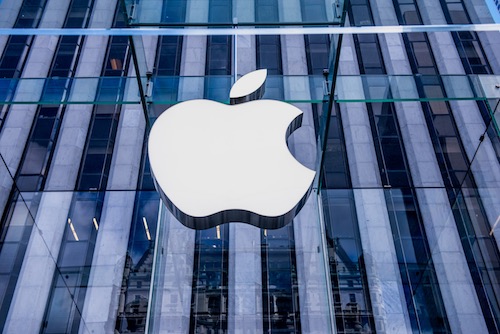“Ultimately, Apple’s assertions amount to little more than an expression of its displeasure with a license provision into which it voluntarily entered.”
 The U.S. Court of Appeals for the Federal Circuit (CAFC) yesterday dismissed two appeals filed by Apple against Final Written Decisions of the Patent Trial and Appeal Board (PTAB) finding that Apple did not prove certain claims of two Qualcomm patents obvious.
The U.S. Court of Appeals for the Federal Circuit (CAFC) yesterday dismissed two appeals filed by Apple against Final Written Decisions of the Patent Trial and Appeal Board (PTAB) finding that Apple did not prove certain claims of two Qualcomm patents obvious.
The appeal stems from a suit brought by Qualcomm in the U.S. District Court for the Southern District of California for infringing claims of its U.S. patents 7,844,037 and 8,683,362. Apple subsequently petitioned for inter partes review (IPR) of claims 1–14, 16–18, and 19–25 of the ’037 patent and claims 1–6 and 8–20 of the ’362 patent. The Board held that Apple did not prove the challenged claims in either patent would have been obvious, but then Apple and Qualcomm settled all worldwide litigation between them. The parties thus moved to dismiss Qualcomm’s district court action with prejudice, which the district court granted, but Apple appealed the Board’s final written decisions anyway.
No Standing
First, the CAFC agreed with Qualcomm’s argument that Apple failed to address or submit evidence supporting standing in its opening brief and thereby waived its argument to establish standing in the appeal. “Given the global settlement between the parties, Apple should have made its standing arguments and proffered its evidence in support of standing in its opening brief,” said the court. However, the court exercised its discretion to reach the issue of standing anyway, because it could impact these and other appeals.
Apple argued that it has standing to appeal because of 1) ongoing payments as a condition in the license agreement; 2) the threat they may be sued once the license agreement expires; and 3) “the estoppel effects of 35 U.S.C. § 315 on future challenges to the validity of the ’037 patent and ’362 patent.”
Apple cited MedImmune, Inc. v. Genentech, Inc to support its argument for standing based on payment obligations under the license agreement, but the CAFC said it did not read MedImmune as broadly as Apple suggested. Unlike in MedImmune, Apple did not allege that the validity of the patents at issue would affect its ongoing royalty obligations. “This failure is fatal to establishing standing under the reasoning of MedImmune, whether we analyze Apple’s evidence for injury in fact or redressability,” said the court. The license agreement involves “tens of thousands” of patents and the validity of any single patent would have no effect on Apple’s ongoing payment obligations. The court added: “Ultimately, Apple’s assertions amount to little more than an expression of its displeasure with a license provision into which it voluntarily entered. Such allegations do not establish Article III standing.”
Unspecific and Speculative
As to Apple’s argument that it may be sued after the expiration of the license agreement, the court said “this possibility of suit is too speculative to confer standing” and that Apple had provided no evidence to suggest it plans to engage in infringing activity after the expiration of the license. “In fact, Apple offers the sparsest of declarations in support of standing, which are devoid of any of the specificity necessary to establish an injury in fact,” said the court. The CAFC further rejected Apple’s suggestion to take judicial notice that the company sells and will continue to sell its smartphone products because “[w]hat products and product features Apple may be selling at the expiration of the license agreement years from now are not the kind of undisputed facts we may take judicial notice of because they may be reasonably questioned.” Apple also failed to provide “the specificity necessary to show that Qualcomm is likely to assert these particular patents against any particular products which would be sold after the license agreement expires in 2025 or 2027,” said the court.
Finally, Apple’s argument that “its injury is compounded by the likelihood that 35 U.S.C. § 315(e) would estop it from arguing that the ’037 patent and ’362 patent would have been obvious in future disputes” has already been rejected under AVX Corp. v. Presidio Components, Inc., said the court, adding that “Apple’s harm is particularly suspect” due to its failure to show it will be engaging in infringing activities.
The court thus dismissed Apple’s appeals for failure to show standing.
Image Source: Deposit Photos
Author: alexeynovikov
Image ID: 153617898

![[IPWatchdog Logo]](https://ipwatchdog.com/wp-content/themes/IPWatchdog%20-%202023/assets/images/temp/logo-small@2x.png)

![[[Advertisement]]](https://ipwatchdog.com/wp-content/uploads/2023/01/2021-Patent-Practice-on-Demand-1.png)
![[Advertisement]](https://ipwatchdog.com/wp-content/uploads/2024/05/Quartz-IP-May-9-2024-sidebar-700x500-1.jpg)
![[Advertisement]](https://ipwatchdog.com/wp-content/uploads/2024/04/Patent-Litigation-Masters-2024-sidebar-700x500-1.jpg)

![[Advertisement]](https://ipwatchdog.com/wp-content/uploads/2021/12/WEBINAR-336-x-280-px.png)
![[Advertisement]](https://ipwatchdog.com/wp-content/uploads/2021/12/2021-Patent-Practice-on-Demand-recorded-Feb-2021-336-x-280.jpg)
![[Advertisement]](https://ipwatchdog.com/wp-content/uploads/2021/12/Ad-4-The-Invent-Patent-System™.png)






Join the Discussion
One comment so far.
Pro Say
April 8, 2021 02:52 pmOne. Bad. Apple.